A forestry program has helped raise living standards on the Loess Plateau. Xin Wen reports from Jixian county, Shanxi.
At one time, farmers on the Loess Plateau in Shanxi province could only plant crops they knew were sturdy enough to resist the effects of frequent droughts and thrive in the area's thin soil.
However, the development of an "ecological forest" program has resulted in a wider range of choices, which means the locals are able to cultivate their own orchards while protecting the fragile ecology at the same time.
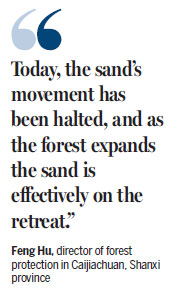
Shanxi is one of several areas where the arid loess soil has been turned a lush green.
The area is now home to more than 3,000 cooperatives, loose affiliations that employ about 66,000 impoverished farmers who share resources but are free to decide which crops to grow.
Having lived on the plateau for more than 40 years, Zhong Sheng used to work the dry land endlessly, but his life has changed markedly since he became a forest ranger in the 1990s.
The 60-year-old cultivates and preserves trees and saplings, which form a barrier against the wind and prevent the soil from being blown away, as well as trapping moisture. He has not only witnessed the transformation of an infertile area into an oasis of greenery, but has also seen his income and personal circumstances improve.
Zhong is one of many beneficiaries of an afforestation program in Caijiachuan, Jixian county, in the southwest of the province.
In addition to the 1,000 yuan ($150) a month he earns as a ranger, he makes 30,000 yuan a year from the 0.27 hectares of apple trees he planted in 2015.
Before becoming a ranger almost 30 years ago, Zhong earned about 8,000 yuan a year. The income was barely enough to feed him, his wife, three sons and a daughter, and the family lived in a cottage made from compacted earth. He never imagined that he would move to a brick-and-mortar home at the age of 50.
By the end of last year, 2,257 cooperatives had been formed in Shanxi, generating 470 million yuan and resulting in each farmer's income rising by 8,700 yuan a year.
The number of cooperatives has continued to rise this year.
Afforestation programs are one of the ways the central government plans to lift rural residents out of poverty.
In January, it pledged to further bolster the ecological industry by establishing 12,000 cooperatives nationwide by 2020.
They will employ 100,000 people to develop forests and woodlands, and, overall, the project will benefit about 15 million impoverished people.
Rising incomes
The Loess Plateau presents a special challenge because its 640,000 square kilometers constitute the largest area of soil erosion in the world.
Even though the land is scarred by thousands of gullies and ravines caused by frequent heavy flooding of the Yellow River, the water drains through the loose soil and evaporates rapidly as a result of the flat terrain.
The cultivation of forests and woodland is intended to prevent erosion, conserve water and improve living standards.
In the past 10 years, 150 hectares in Caijiachuan have been planted with walnut, apple and pear trees, which has raised the forestry rate to 84 percent from less than 10 percent.
Last year, apples were cultivated on more than 18,000 hectares in Jixian county, generating profits of 796 million yuan and helping about 80,000 people in 30,000 households achieve sustainable income growth. Overall, apple cultivation accounted for 80 percent of the combined income of the county's residents.
In 2005, Liu Xinzhu planted 0.93 hectares of apple trees in Jixian county.
Having specialized in varieties such as Red Fuji and Gala, his income is now 10 times higher than it was 13 years ago.
"I can save money now and prepare for my grandchildren's futures. Before, I could barely feed my family," the 67-year-old farmer said.
The family's income is supplemented by Liu's son who lives away from home as a migrant worker, and Liu plans to develop his home into a tourism center, providing accommodation and food for visitors from the city.
"If more people came to buy our delicious apples, our circumstances would improve even more," he said.
Special cooperatives
In recent years, a new work pattern has emerged via cooperative unions, umbrella organizations formed by large numbers of cooperatives banding together.
All participants plant the same crop, which helps them master specific cultivation techniques, and they all enjoy government subsidies. About 60 percent of members are officially classified as impoverished, according to Liu Zengguang, director of the Shanxi Forestry Bureau.
Moreover, every farmer who participates in the forest planting program is given a subsidy of 800 yuan, and the program's success has improved conditions for crop cultivation, which has resulted in farmers' incomes rising, the local government said.
Last year, 228 specialized cooperatives had been established in the province, benefiting 1,461 households, and each one involved 240 cooperatives according to Ma Xiangrong, deputy director of operations for the Shanxi Agriculture Department.
By the end of last year, 370,000 people in the province were forest rangers.
"The locally grown trees have basically become money trees for the farmers, compared with the area's traditional agricultural industry where crops were destroyed by drought and floods, leaving the farmers with nothing to show for their efforts, according to Liu Zengguang.
The financial success of fruit cultivation has prompted the farmers to grow more trees, raising their incomes while protecting the fragile ecological environment.
Opportunities
Feng Hu, director of forest protection in Caijiachuan, has witnessed the change in the microclimate as a result of the growing forestry coverage. For example, the amount of rainfall has risen by about 10 percent in the past decade.
"Before, one of my biggest concerns was whether the plants would receive enough water, but that has ceased to be a problem since the forest defense came into being," said the 36-year-old Caijiachuan native.
The area is becoming known as a microcosm of the country's long battle against desertification, but there is still a long way to go, not only for China, but globally.
In the past 40 years, the Earth has lost one-third of its arable land to erosion and degradation, according to a 2013 report by the United Nations Convention to Combat Desertification.
The report noted that desertification, land degradation and drought accelerated worldwide during the 20th century, especially in arid, semi-arid and dry sub-humid areas, and predicted that the process will intensify in the next 100 years.
However, that sentiment seems a world away from Caijiachuan, a watershed on a tributary of the Yellow River, where plans are being made to transform the area into a national forest park in light of its growing fame as an area of lush, green beauty.
"There used to be only one color - yellow," Feng said. "In the old days, sand ruled the land. Today, the sand's movement has been halted, and as the forest expands the sand is effectively on the retreat."
Contact the writer at xinwen@chinadaily.com.cn
|
Cooperative members in Lanxian county, Shanxi province, prepare the ground before planting trees as part of a forestry program.Cao Yang / Xinhua |
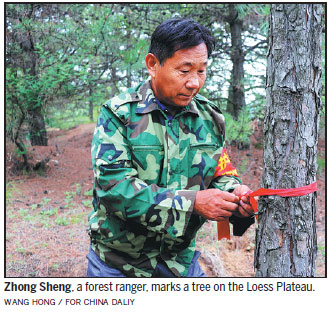
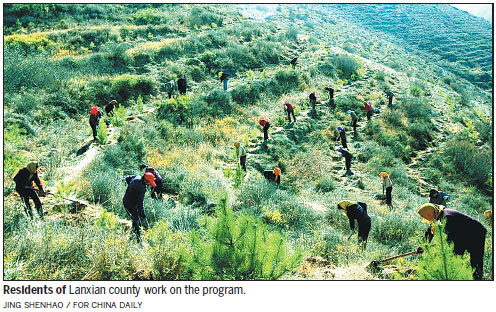
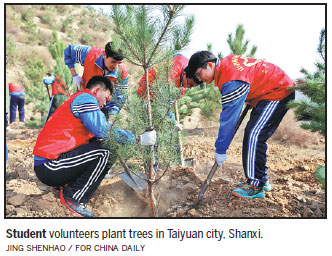
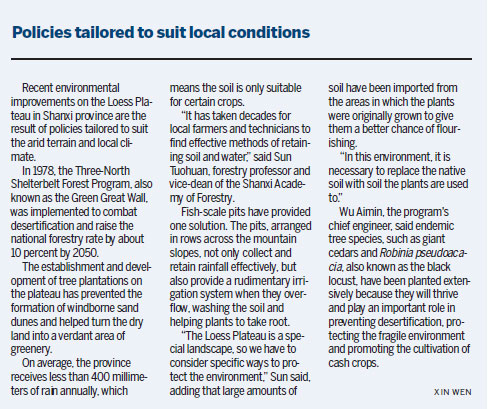
(China Daily 07/02/2018 page6)